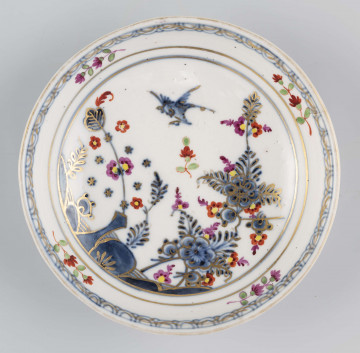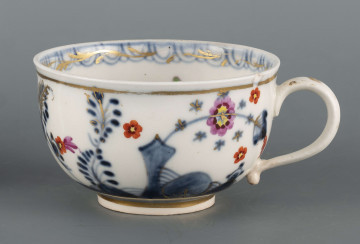
Creamer jug
1825 — 1835
National Museum in Lublin
Part of the collection: European porcelain
The plate has a rich and varied decoration, both painted and plastic. The relief pattern on the collar consists of quadrilateral strands of the braid, forming squares set diagonally to the edges of the dish. This type of decoration was first used in Meissen on a service made in 1735-1736 for Count Alexander Joseph Sulkowski and his wife Maria Anna Frein von Stein, hence the name.
The painting decoration imitates Japanese porcelain manufactured in the Arita region, and its name derives from the Kakiemon family of ceramists. In the middle of the 17th century it was they who first used glazing paints adopted from China. Their patterns with asymmetrical composition and delicate drawing consisted of plant motifs supplemented with animal and bird representations. They were widely imitated throughout Japan, later in China and from the 18th century in Europe, starting in Meissen in Germany in 1728. The decoration had a symbolic meaning. The chrysanthemum in Asian culture is full of optimism because it symbolises happiness and long life. As a symbol of the sun, the radial arrangement of the petals brings joy and cheerfulness. In Asia, the cuckoo symbolises spring, and for centuries in Europe has been considered an omen. Its cuckoo call foretells the arrival of marriage, and the number of cuckoo calls the number of years separating a girl from her wedding. The craftsmen in Meissen tried to reproduce the designs taken from Japanese porcelain faithfully, but sometimes they also added something of their own, for example, tiny flowers and insects painted to hide blemishes on the dish's surface.
Barbara Czajkowska
Author / creator
Dimensions
cały obiekt:
Object type
plate
Technique
overglaze paints
Material
porcelain
Creation time / dating
Creation / finding place
Owner
The National Museum in Lublin
Identification number
Location / status

1825 — 1835
National Museum in Lublin

1890 — 1800
National Museum in Lublin

1790 — 1800
National Museum in Lublin
DISCOVER this TOPIC
Castle Museum in Łańcut
DISCOVER this PATH
Educational path